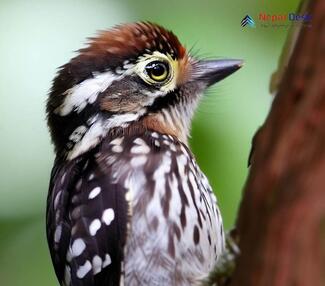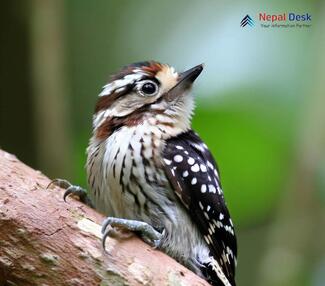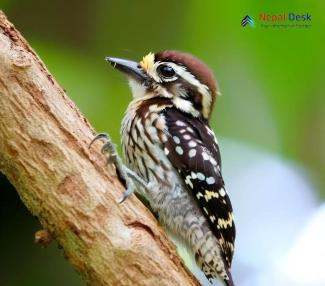Nepal, a country known for its breathtaking landscapes and rich cultural heritage, is also home to a spectacular array of bird species. Among these avian wonders is the Brown-capped Pygmy Woodpecker (Yungipicus nanus), a small but fascinating bird that can be found throughout Nepal's diverse ecosystems. This captivating creature not only contributes to the country's thriving biodiversity, but also offers birdwatching enthusiasts a unique opportunity to observe its behavior and habitat up close. Here in this article, we shall be looking at the various aspects of this bird.
A Petite Powerhouse: Physical Characteristics
The Brown-capped Pygmy Woodpecker is indeed small in stature, measuring just 12-14 centimeters in length with a weight of approximately 20 grams. However, this diminutive bird is anything but weak. It boasts a strong, sharp beak perfectly adapted for drilling into tree bark in search of insects and their larvae. Its brown cap, black and white plumage, and distinctive barring pattern provide excellent camouflage while it forages among tree trunks and branches.
Habitat and Distribution: A Broad Range Across Nepal
The Brown-capped Pygmy Woodpecker can be found across much of Nepal, with sightings recorded from the lowland Terai region to the foothills of the Himalayas up to elevations of 2,500 meters. This adaptable species inhabits a variety of ecosystems, including tropical and subtropical forests, open woodlands, and well-treed gardens or parks. Wherever there are trees with suitable bark for pecking, there's a good chance you'll spot this tiny woodpecker hard at work.
Behavior and Diet: Nimble Foragers with an Appetite for Insects
These agile birds are expert foragers who adeptly navigate through tree branches, frequently adopting a variety of acrobatic poses and clinging to vertical surfaces with ease. Their primary diet consists of small insects and their larvae, which they expertly extract from crevices using their long, barbed tongue. Occasionally, they have also been known to feed on fruits or berries.
Conservation and Birdwatching Opportunities
Though the Brown-capped Pygmy Woodpecker is not currently listed as a threatened species, its habitat faces challenges from deforestation and other human activities. Efforts to conserve Nepal's unique ecosystems and protect its abundant birdlife are crucial for preserving the natural beauty that makes this country so special.
For birdwatching enthusiasts eager to catch a glimpse of this captivating woodpecker, Nepal offers ample opportunities to explore pristine forests and well-treed parks teeming with avian life. Don't forget your binoculars – the charming Brown-capped Pygmy Woodpecker is a sight you won't want to miss!




